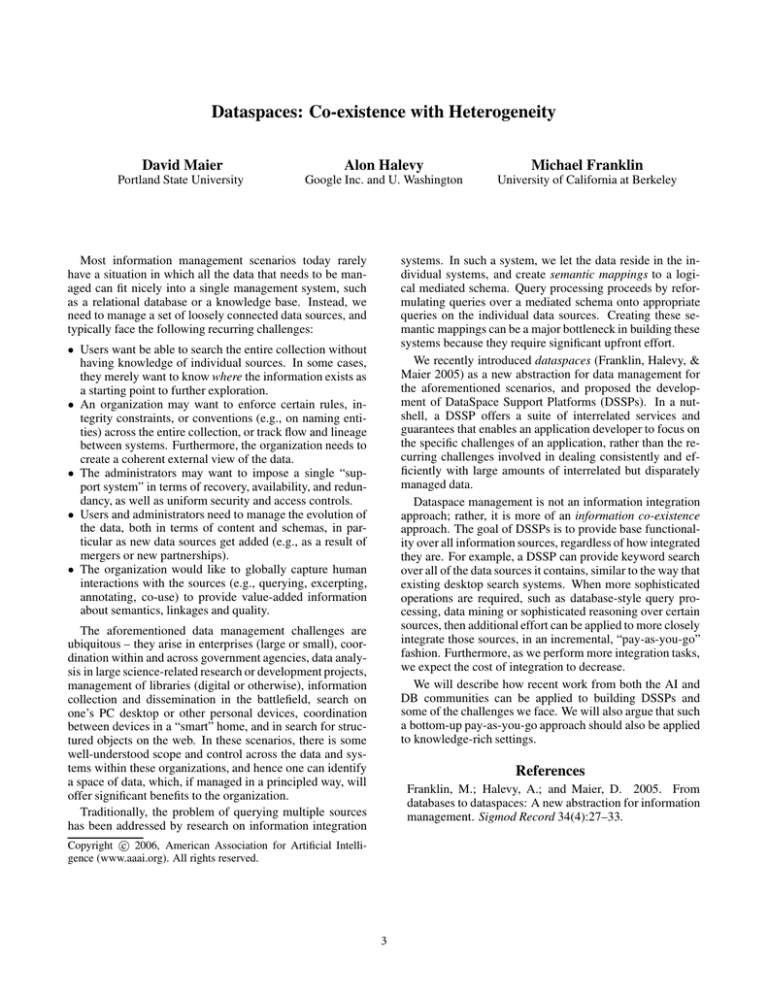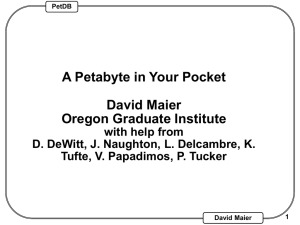
Dataspaces: Co-existence with Heterogeneity
David Maier
Portland State University
Alon Halevy
Google Inc. and U. Washington
Most information management scenarios today rarely
have a situation in which all the data that needs to be managed can fit nicely into a single management system, such
as a relational database or a knowledge base. Instead, we
need to manage a set of loosely connected data sources, and
typically face the following recurring challenges:
Michael Franklin
University of California at Berkeley
systems. In such a system, we let the data reside in the individual systems, and create semantic mappings to a logical mediated schema. Query processing proceeds by reformulating queries over a mediated schema onto appropriate
queries on the individual data sources. Creating these semantic mappings can be a major bottleneck in building these
systems because they require significant upfront effort.
We recently introduced dataspaces (Franklin, Halevy, &
Maier 2005) as a new abstraction for data management for
the aforementioned scenarios, and proposed the development of DataSpace Support Platforms (DSSPs). In a nutshell, a DSSP offers a suite of interrelated services and
guarantees that enables an application developer to focus on
the specific challenges of an application, rather than the recurring challenges involved in dealing consistently and efficiently with large amounts of interrelated but disparately
managed data.
Dataspace management is not an information integration
approach; rather, it is more of an information co-existence
approach. The goal of DSSPs is to provide base functionality over all information sources, regardless of how integrated
they are. For example, a DSSP can provide keyword search
over all of the data sources it contains, similar to the way that
existing desktop search systems. When more sophisticated
operations are required, such as database-style query processing, data mining or sophisticated reasoning over certain
sources, then additional effort can be applied to more closely
integrate those sources, in an incremental, “pay-as-you-go”
fashion. Furthermore, as we perform more integration tasks,
we expect the cost of integration to decrease.
We will describe how recent work from both the AI and
DB communities can be applied to building DSSPs and
some of the challenges we face. We will also argue that such
a bottom-up pay-as-you-go approach should also be applied
to knowledge-rich settings.
• Users want be able to search the entire collection without
having knowledge of individual sources. In some cases,
they merely want to know where the information exists as
a starting point to further exploration.
• An organization may want to enforce certain rules, integrity constraints, or conventions (e.g., on naming entities) across the entire collection, or track flow and lineage
between systems. Furthermore, the organization needs to
create a coherent external view of the data.
• The administrators may want to impose a single “support system” in terms of recovery, availability, and redundancy, as well as uniform security and access controls.
• Users and administrators need to manage the evolution of
the data, both in terms of content and schemas, in particular as new data sources get added (e.g., as a result of
mergers or new partnerships).
• The organization would like to globally capture human
interactions with the sources (e.g., querying, excerpting,
annotating, co-use) to provide value-added information
about semantics, linkages and quality.
The aforementioned data management challenges are
ubiquitous – they arise in enterprises (large or small), coordination within and across government agencies, data analysis in large science-related research or development projects,
management of libraries (digital or otherwise), information
collection and dissemination in the battlefield, search on
one’s PC desktop or other personal devices, coordination
between devices in a “smart” home, and in search for structured objects on the web. In these scenarios, there is some
well-understood scope and control across the data and systems within these organizations, and hence one can identify
a space of data, which, if managed in a principled way, will
offer significant benefits to the organization.
Traditionally, the problem of querying multiple sources
has been addressed by research on information integration
References
Franklin, M.; Halevy, A.; and Maier, D. 2005. From
databases to dataspaces: A new abstraction for information
management. Sigmod Record 34(4):27–33.
c 2006, American Association for Artificial IntelliCopyright gence (www.aaai.org). All rights reserved.
3






